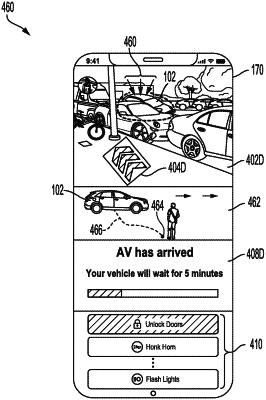| CPC G08G 1/205 (2013.01) [B60W 10/30 (2013.01); G05D 1/0038 (2013.01); G05D 1/0248 (2013.01); G08G 1/202 (2013.01); G06T 19/006 (2013.01)] | 20 Claims |

|
1. A method comprising:
determining a first location of an autonomous vehicle (AV) relative to a second location of a client device associated with a user that requested a ride from the AV;
based on the first location of the AV relative to the second location of the client device, determining a direction from the second location of the client device to the first location of the AV;
presenting, at the client device, an audio cue informing the user that a user action can be performed to activate an augmented reality (AR) wayfinder feature wherein the user action comprises holding the client device vertically;
in response to performance of the user action of holding the client device vertically, presenting, at the client device, a real-time feed from a camera sensor associated with the client device, the real-time feed comprising a local scene captured by the camera sensor and the real-time feed being from a viewpoint of the camera sensor;
presenting a virtual content overlay on the real-time feed presented at the client device, the virtual content overlay comprising a first indication of the direction from the second location of the client device to the first location of the AV;
presenting, at the client device, one or more selectable interface controls for remotely triggering activating a horn on the AV and unlocking the doors on the AV;
determining that the AV is outside of a field-of-view (FOV) of the camera sensor;
in response to determining that the AV is outside of the FOV of the camera sensor, presenting, at the client device, a virtual pointer instructing the user to point the camera sensor in a different direction determined to place the AV within the FOV of the camera sensor, wherein a size of the virtual pointer is based on a distance between the AV and the client device, and continuing, after a handoff between the AV and the client device, to provide, on the client device, wayfinding information from a drop-off location associated with the ride to a final destination.
|